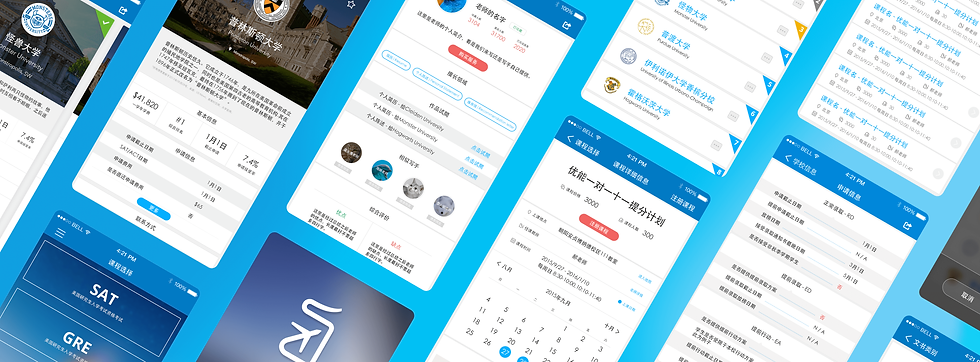Reinventing the U.S. College Application Experience for 300,000 Chinese Students
I designed an iOS app that allows users to accelerate their decision-making process on target colleges and to formulate the best application strategy.
MY ROLE
User Research, Information Architecture, Visual Design, User Testing
MY TEAM
1 Project Manager, 2 Front-end Developers, 3 Back-end Developers
YEAR
2016

Why This Project
300,000 Chinese students studied in the U.S in 2014 and this number is still increasing over the past four decades.
Due to the complexity of the application process, applicants tend to hire a consultant to develop an application strategy. But the service requires an average of $20,000 (equivalent to 1/3 of average Chinese family's income) for a limited-time consulting service.
With such pricey services established, it is clear that Chinese applicants continue to struggle with the intricacies of the college application process.
The Problem
Applications found it difficult to decide on colleges because of the disorganized information. But when reaching out to an application strategist, applicants found it difficult to build trust upon him or her without enough understanding of his or her ability.
Overwhelming and Disorganized Information Makes It Difficult to Decide on Colleges
By conducting user interviews, I formed a solid understanding of how an applicant selects target colleges. Applicants were mostly struggling with
numerous resources, which made them more confused and distracted. They are looking for a simple system that delivers required school information.
A lack of trust in the consultant makes it hard to apply application strategy with confidence
Without enough understanding of the consultant, applicants find it difficult to build trust upon him or her. The lack of confidence in the proposed strategy causes hesitation.
Below shows the steps an applicant take to apply to a U.S. college. User pain points are marked in red.

The Concept
To create a better way to select target colleges, I first identified the required information for the decision-making process, then organized the information in a way that is easy to navigate and digest.
Required Information for the Decision-making Process
Research revealed that applicants initiate a list of target colleges based on college rankings and locations, then finalize the list based on academic resources and expenses. Some of the applicants are also interested in seeing application information and admission information prior to the application process.

I further prioritized the information and organized them into screens.

Translate Information into Design
Through sketch, wireframes, and prototypes, I created all the interfaces and presented it to the team for discussion.
Sketch

Wireframe

Prototype

User Testing Reveals The Good & The Bad
Testers liked how the application presents the information and the amount of information the application provides, but they did not like the design, noting too many visual distractions.
“This [app] is definitely easier for me to navigate...the amount [of the information] is just enough.”
"The design is too overwhelming. I would prefer the page to focus more on the content, not having these many triangles and lines."
After another round of iteration, I finalized the design.

The Outcome
College Info One Stop Shop
Starting with a simple ranking, users can focus on colleges, not ranking lists. To accommodate additional interests, custom filters are available as well.
By segmenting the information, users can quickly navigate to the desired information.




Customizable Application Strategy




The up-front list of available skill enhancement courses allows users to purposefully customize their application strategy.


The # of likes and customer reviews helps build trust in the consultant's ability.

Work preview and customer reviews allow users to evaluate the consultants thoroughly before deciding to work with them.
The "Previous Students" section provides another channel for applicants to understand the consultant's ability.
The Lesson
Persistence and Persuasion is essential to UX Success
It's not uncommon for a team to start a project without any user feedback. For this project, I found myself constantly emphasizing the importance of user research and user testing. It was challenging at the beginning, but by involving the team in the UX process and sharing user feedback with them, the team started to appreciate the insights UX brought to the team. In the end, we were rewarded with overwhelmingly positive feedback and recognition.

